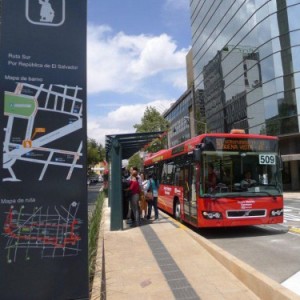
In 2005, Mexico City inaugurated its first bus rapid transit (BRT) corridor on a high-profile avenue running through the heart of the Mexican capital. Metrobus now serves over 450,000 passengers per day, nearly half the number of passengers who ride Washington, DC’s entire Metro system, the second-largest urban rail network in the United States. In addition, the Spanish Carbon Fund, an initiative to pay for projects that reduce greenhouse gas emissions, has awarded Mexico City $307,000 for the carbon dioxide emissions that Metrobús reduces.
A year after its launch, Metrobús had received such high ratings from the public that Marcelo Ebrard, the mayor of Mexico City, campaigned on a platform of expanding Metrobús from a one-line operation to a citywide network of 10 lines. Once elected, he has worked to keep his campaign promise; already he has opened Insurgentes Sur, a 9.5-kilometer, handicapped-accessible extension of Metrobús, and has begun planning and constructing the other lines.
Mexico City’s Metrobús system launched its second bus rapid transit corridor, “Eje 4 Xola,” in December 2008. The new 36-station line serves nearly 120,000 passengers per day. Traveling by trolleybus along the original length of the corridor used to take up to two hours; riding Metrobús along the same route now takes about 55 minutes. Along Insurgentes—the longest avenue in the city—Metrobús has improved mobility by 50 percent, reduced accidents by 30 percent, and encouraged an estimated 6% shift from private vehicles to public transport.
Line 4 of Mexico City’s Metrobus opened on April 1, 2012, with an inauguration by Mayor Marcelo Ebrard, connecting the historic city center to the airport. Unlike many BRTs in Latin America, the route passes through the historic center, running on two major north/south axes along Republica de Venezuela and Heroe de Nacozari in the north and Republica de el Salvador south of City Hall. The new line is projected to carry about 50,000 passengers in 54 12 meter buses.
The line makes vital direct connections to Lines 1 and 3 of the existing BRT, as well as the Buenavista commuter rail terminal, and both terminals of the Mexico City International Airport. Initial estimates expect that the new line will reduce travel time from the Centro Historico to the airport from 1.5 hours to just 50 minutes. The addition of this line makes Metrobus’ network approximately 100 kms and increases its capacity to more than 700,000 passengers per day.